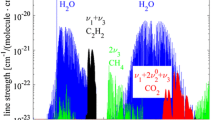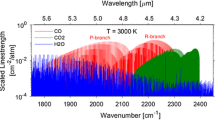Abstract.
The residence-time of the flue gas in a furnace is an important parameter for a complete and clean combustion. A new method to determine the residence-time has been developed and is presented for the first time. It is based on the injection of alkali compounds as a tracer. Alkali atoms that are produced by thermal decomposition of the tracer are detected in the hot flue gas after passage of the combustion facility. This is done without any gas sampling using direct tunable diode laser based absorption spectroscopy. Different diode laser (DL) types (Fabry–Pérot DLs, external-cavity DLs, and vertical-cavity surface-emitting lasers) were analyzed and used to develop several spectrometers for the in situ detection of lithium (671 nm), potassium (770 nm), and rubidium (780 nm). Various spectrometers were built for single- or multi-species detection using a single laser, for time-multiplexed multi-species detection using two lasers, and for multi-path detection at two different locations along the flue-gas duct. To evaluate the system performance the potassium atom background caused by the fuel was continuously monitored in the post-combustion chamber (PCC) for several weeks. A typical concentration range of 1 ng to 1 μg at STP (800 ppq to 800 ppt; ppq=10-15) was observed. By averaging 100 individual absorption scans the response time was 2.7 s. The minimum detectable absorption was about 10-4 optical density, corresponding to a detection limit of 4×1011 K atoms/m3 at 1200 K instead of ‘°K’. (K(D2) absorption line; 1.9-m absorption path). This is equivalent to a detection limit of 0.1 ng/m3 at STP or 80 ppq. The fastest response time (0.16 s) was achieved by evaluating single absorption scans. Two combustion facilities at the Forschungszentrum Karlsruhe (a batch combustor and a 3-MW special waste incinerator with a rotary kiln followed by a PCC) were investigated. Alkali chlorides were added to the combustion chamber in different forms, of which short spray pulses of an aqueous salt solution was the method of choice for the residence-time measurement. Flow-time distributions were measured and the mean residence-time was calculated for various operation conditions. A simultaneous flow-time measurement at two different locations (8.4 m/17.0 m from the tracer discharge location) was realized with a binary K/Rb tracer and a multi-species spectrometer. Mean residence-times of (±) 151s and (±) 261s were observed and met the expected values.
Similar content being viewed by others
Author information
Authors and Affiliations
Additional information
Received: 29 April 2002 / Revised version: 21 June 2002 / Published online: 2 September 2002
RID="*"
ID="*"Corresponding author. Fax: +49-6221/5450-50, E-mail: volker.ebert@pci.uni-heidelberg.de
This paper is dedicated to Prof. Dr. Gottfried Huttner on the occasion of his 65th birthday.
Rights and permissions
About this article
Cite this article
Schlosser, E., Wolfrum, J., Hildebrandt, L. et al. Diode laser based in situ detection of alkali atoms: development of a new method for determination of residence-time distribution in combustion plants. Appl Phys B 75, 237–247 (2002). https://doi.org/10.1007/s00340-002-1001-x
Issue Date:
DOI: https://doi.org/10.1007/s00340-002-1001-x




